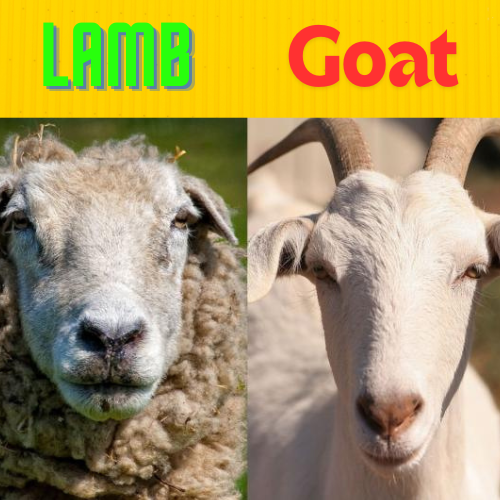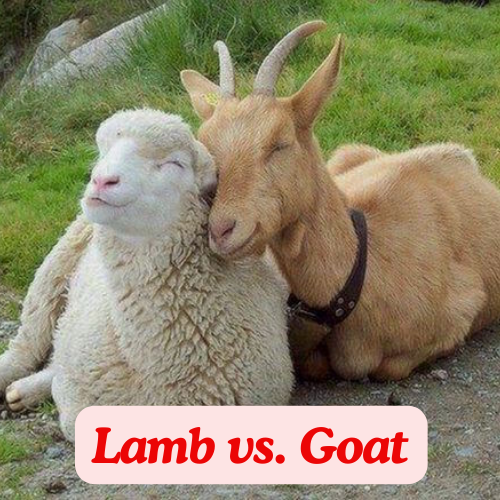Lamb vs Goat:- Discover the key differences between Lamb vs Goat, including their physical characteristics, diets, and meat varieties. Learn how to distinguish between these two animals and understand their unique nutritional benefits.



Lamb Vs Goat Are From Different Scientific Genera
There are significant differences to talk about when comparing lamb vs. goat, but what might some of these differences be? For starters, lambs and goats are from different scientific genera. Goats are from the Capra genus, while lambs are from the Ovis genus, but this is just the beginning of their main differences.
In this article, we will discuss all of the differences between these two animal species, including how you can tell them apart and any other relevant information. Before long, you can tell the difference between a lamb and a goat without hesitation! Let’s dive in and learn more now.
Comparing Lamb vs Goat
There are many key differences between lambs and goats. Lambs are considered young sheep, while goats refer to a goat at just about any age. Goats and lambs are also very different in their appearance, with lambs having white and woolen fur, while goats come in a variety of colors and have hair rather than wool. But this is just the beginning of their differences.
Lamb vs Goat: Age
The primary difference between lambs and goats has to do with age. Lambs are young sheep, usually under one year of age, while goats are called goats at any age, but especially when they are adults. Young goats are often called kids, so comparing lambs and goats automatically has to do with the age of the animal.
Lambs Tend To Look Much Younger\Lamb vs Goat
The difference in age between a lamb and a goat can also affect their appearance. While it can be hard to tell how old a goat is, lambs tend to look much younger than their older sheep counterparts.
Lamb Vs Goat: Fur Types
Another key difference between lambs and goats is their fur types. Goats have a hairy coat, while lambs are just beginning to grow their trademark wool. While lambs will not have very thick coats until their adult years, you can still tell the difference between goat hair and lambswool.
Goat Hair Is Coarse And Ranges In Length
For example, wool is dense and soft, while goat hair is coarse and ranges in length. Some goats have very long hair while others have short hair, and all lambs have shorter wool than their adult sheep counterparts, given their age. Most lambs reach peak wool production when they become adults, and their optimum wool age is between 3-5 years.
Uses Of Lambs
This could be considered another key difference between lambs and goats: they are raised for different reasons. Lambs and goats are both raised for culinary purposes as well as farm purposes, but lambs will likely be used for their fleece and wool, while goat hair isn’t used in any commercial capacity.
Lamb vs Goat: Horns
When comparing lamb and goat, an obvious difference can be found in their horns. Lambs will never be born with horns, but some goats are. Sheep can grow horns as they age, like goats, but lambs do not develop horns until they are well into adulthood.
Goat Horns Are Uniquely Shaped
If Lambs grow up and develop horns as adults, these horns will still be very different from goat horns. For example, many sheep grow their horns on the sides of their heads, while goat horns are found atop their heads. Sheep horns can also be rounded, while goat horns are often pointy or uniquely shaped.
Lamb vs Goat: Tail
Another key difference between lambs and goats is the appearance of their tail. Lambs and sheep have tails that point downward, and they are often thick and wooly, while goat tails point upward, and they are more slender and hairy.
Easy Way To Identify Lambs And Goats
This can be an easy way to tell lambs and goats apart, given that goats often have erect and active tails. Lambs often have their tails docked at a young age, for their health and safety. The same can also be said for goats, but goats have fewer health issues with their tails when compared to sheep.
Lamb vs Goat: Diet
A final key difference between lambs and goats has to do with their diet. Lambs receive a decent amount of their nutrition from their mother’s milk, while goats are old enough to figure out their nutrition. However, even lambs transition to eating solid foods while within their first months of life, similarly to goats.
Lambs And Sheep Are Considered Grazers
What goats and lambs choose to eat is where they differ as well. Lambs and sheep are considered grazers, while goats are browsers, a phrase that means goats tend to eat whatever they feel like as they come upon it. Goats often eat plants, twigs, leaves, and shrubs at their eyeline. Lambs and sheep graze for the grasses found on the ground.
However, just like lambs, baby goats also need their mother’s milk to survive. Plant matter soon becomes important for their nutrition, but both lambs and baby goats need a combination of both food sources to grow into healthy adults.
What’s the Difference Between Lamb and Goat Meat?
Sheep, lamb, goat, and kid meat are consumed in various parts of the world. Generally, sheep meat is called mutton, but in some parts, goat meat is called mutton. Lamb is simply called lamb.
In terms of taste, goat meat has a mild and slightly sweet flavor, because goats eat a variety of vegetation, including herbs. Lambs, on the other hand, graze in pastures of grass, causing their meat to taste gamey and rich.
Goat meat has a lower fat content than lamb, but more calories and protein than mutton, making it healthier, but both goat and lamb have vitamins and minerals that are beneficial to humans. However, lamb meat is more vitamin-rich, while goat meat is more mineral-rich.
The preparation of goat meat and lamb meat is also different. As goat meat tends to be tougher, it’s usually smoked, roasted, or braised. Lamb meat, on the other hand, is more delicate and tender, so is sometimes cooked quickly by pan-frying but, in other cases, slow-roasted.
Conclusion\Lamb vs Goat
In conclusion, whether you’re a local farmer, a gourmet, or just inquisitive, knowing the distinctions between goat and lamb is crucial. Lambs and goats each provide something odd, from their different physical characteristics such as fur, horns, and tails to their various dietary habits, meat qualities, and flavour. Knowing how to recognize them on a farm or deciding which of their meat to buy for your next dinner will enable you to distinguish the special characteristics of these animals. In the end, goats and lambs are both extremely nourishing and have significant functions in a variety of worldwide culinary traditions.





